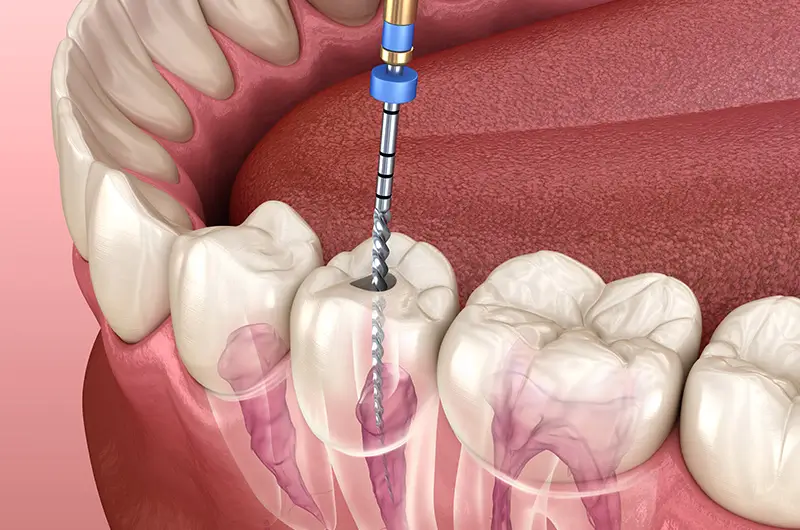Root Canal Treatment: How Endodontics Helps Save Your Natural Teeth

What Is Endodontics?
Endodontics is a dental specialty focused on treating the tooth pulp (inner nerves and blood vessels) to save damaged or infected teeth. The most common procedure is root canal therapy, which prevents extraction and maintains your natural smile.
Why Choose an Endodontist?
- Specialized training in complex root anatomy.
- Advanced tools like dental microscopes for precision.
- Expertise in pain management during procedures.
Signs You May Need a Root Canal Treatment
1. Severe Toothache
- Throbbing pain, especially when chewing or applying pressure.
- Sensitivity to hot/cold that lingers for minutes.
2. Swollen Gums or Abscess
- Pimple-like bump near the tooth (pus accumulation).
- Bad taste or foul odor from the infection.
3. Discolored Tooth
- Grayish or darkening tooth due to nerve damage.
4. Cracked/Chipped Tooth
- Exposed pulp from trauma or decay.
The Root Canal Process: Step-by-Step
1. Diagnosis & X-rays
- Digital scans to assess infection spread.
2. Numbing & Isolation
- Local anesthesia for zero pain.
- Rubber dam to keep the tooth dry.
3. Removing Infected Pulp
- Tiny files clean out bacteria from root canals.
4. Disinfection & Sealing
- Antibacterial rinse kills remaining germs.
- Gutta-percha (rubber-like material) seals canals.
5. Restoration (Crown)
- A crown protects the weakened tooth post-treatment.
Debunking Root Canal Treatment Myths
Myth 1: “Root Canals Are Painful”
- Truth: Modern anesthesia makes it as comfortable as a filling.
Myth 2: “Extraction Is Better”
- Truth: Saving your natural tooth preserves jawbone and avoids costly implants.
Myth 3: “Root Canals Cause Illness”
- Truth: No scientific evidence supports this outdated claim.
Root Canal Treatment: In-Depth Guide
Root canal therapy is often misunderstood, but it’s actually a lifesaver for damaged teeth. Let’s explore why this procedure is so important and how it compares to extraction.
Why Roots Canal Therapy is the Preferred Choice
- Preserves Your Natural Tooth
- Keeps your original tooth structure intact
- Maintains normal biting force and sensation
- Prevents neighboring teeth from shifting
- Modern Techniques Make It Comfortable
- Digital imaging for precise treatment
- Rotary instruments for faster, smoother procedures
- Advanced anesthesia for pain-free experience
- Long-Term Oral Health Benefits
- Protects jawbone from deterioration
- Maintains proper chewing function
- Prevents complex dental issues later
The Root Canal Procedure Explained in Detail
- Initial Assessment
- Comprehensive examination
- 3D imaging for accurate diagnosis
- Treatment planning session
- During the Procedure
- Isolation with rubber dam
- Microscopic cleaning of canals
- Laser-assisted disinfection (in advanced cases)
- Post-Treatment Care
- Temporary filling protection
- Follow-up schedule
- Final restoration options
Root Canal vs. Tooth Extraction: Comprehensive Comparison
Clinical Considerations
| Factor | Root Canal | Extraction |
|---|---|---|
| Tooth Survival | Saves natural tooth | Permanent tooth loss |
| Bone Health | Preserves jawbone | Leads to bone resorption |
| Adjacent Teeth | No effect on neighbors | May cause shifting |
| Functionality | Normal chewing restored | Requires prosthetic |
Financial and Practical Aspects
- Cost Comparison
- Root canal: Single investment
- Extraction: Initial savings but…
- Additional costs for implants/bridges
- Long-term maintenance expenses
- Time Investment
- Root canal: 1-2 visits
- Extraction + replacement: Multiple appointments over months
- Recovery Experience
- Root canal: Mild discomfort for 2-3 days
- Extraction: 1-2 weeks healing time
When Extraction Might Be Necessary
- Severe Cases Where Root Canal Isn’t Viable
- Extensive vertical root fractures
- Non-restorable tooth structure
- Advanced periodontal disease
- Patient-Specific Factors
- Medical contraindications
- Financial constraints
- Personal preferences
Making the Right Decision for Your Dental Health
Questions to Ask Your Endodontist
- What’s the long-term prognosis for each option?
- How will this affect my overall dental health?
- What are the maintenance requirements for each choice?
Why F Dental Center Excels in Both Options
- Root Canal Specialists
- Microscope-enhanced procedures
- Gentle techniques for anxious patients
- Same-day emergency services
Aftercare & Recovery Tips
- Avoid chewing on the treated tooth until crowned.
- Brush gently with a soft-bristle toothbrush.
- Attend follow-ups to monitor healing.
FAQs About Endodontics
1. How long does a root canal take?
- Answer: 60–90 minutes (1–2 visits).
2. Can a root canal fail?
- Answer: Rare, but retreatment may be needed if new infection occurs.
3. Is swelling normal after treatment?
- Answer: Mild swelling for 24–48 hours is normal; consult your dentist if it persists.
Why Choose F Dental Center for Endodontics?
- Specialized endodontists with 10+ years of experience.
- Pain-free techniques and sedation options for anxious patients.
- Same-day emergency care for severe infections.

